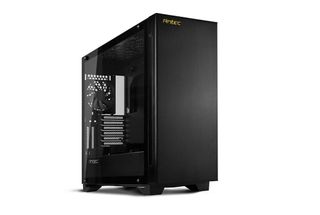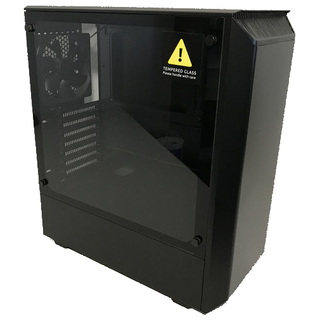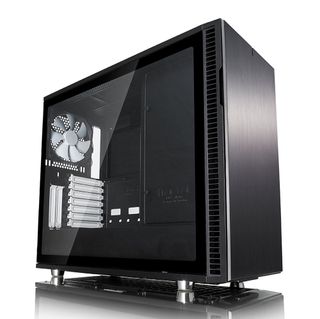Corsair Carbide 275R Tempered Glass Case Review: Clear Winner?
Why you can trust Tom's Hardware
Benchmark Results & Conclusion
We are using the Antec P110 Luce, the Phanteks Eclipse P300, and the Fractal Design Define R6 TG chassis for comparison with our Corsair test unit. They are of similar size and features, and all have tempered-glass side panels.
The thermal performance of the Corsair Carbide 275R is on par with other mid-tower chassis equipped with a single 120mm intake-fan and 120mm exhaust-fan combination, but that isn't saying much. In fact, this chassis turned in numbers almost identical to Corsair's Obsidian 500D chassis.
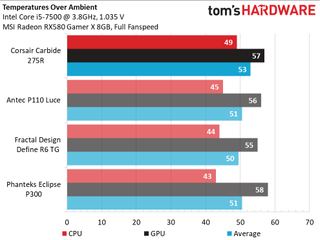
Temperatures on our budget quad-core Core i5-7500 processor running at 3.8GHz ran as high as 49°C over ambient temperature under load. Thanks to the close proximity and position of the 120mm intake fan, the GPU temperatures fared much better than processor temps. The lack of airflow in this chassis had a serious negative impact on its ability to remove the heat generated by the components in our test system.
On the whole, thermal performance lagged behind the cases we used for comparison purposes. Anyone running a high-end or overclocked system would be wise to add at least one (if not more) 120mm intake fans. Again, we would have liked to see at least two intake fans included by default.
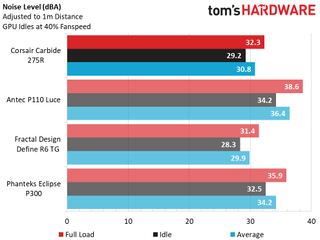
Determining acoustic efficiency, also referred to as "cooling-to-noise ratio," is a matter of averaging all five of our tests to determine a base value.
By now, most people are aware that tempered-glass side panels tend to reflect sound back into the chassis. That, and the inclusion of only two 120mm fans, leaves you with a chassis that is whisper-quiet at idle. Even under load, the Carbide 275R generated very little noise. Unfortunately, glass panels also lead to higher system temperatures. This can be remedied by the addition of one or more intake fans, but that would almost certainly negatively impact these acoustic results.
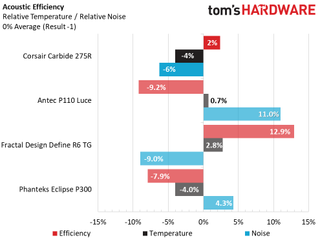
Alas, the higher temperatures reduce the Carbide 275R's value score in our performance-to-price comparison, despite this case's relatively low asking price.
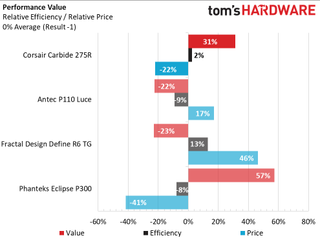
Our Performance Value results are a bit misleading, even now. Most people who buy this chassis will undoubtedly want to add at least one or more intake fans to the system build. That would add to the overall cost of the case, and that in turn would affect the Performance Value rating. Also, even though the added fans will enhance cooling performance, that would more than likely introduce more system noise and negatively impact our acoustic-efficiency rating. As a result, while we like this budget-minded chassis, you'll want to do the price math on an extra fan or two and make sure that the overall cost doesn't push matters into the realm of a pricier case.
MORE: Best Cases
MORE: All Case Content
Current page: Benchmark Results & Conclusion
Prev Page Hardware Installation & Test ConfigurationStay on the Cutting Edge
Join the experts who read Tom's Hardware for the inside track on enthusiast PC tech news — and have for over 25 years. We'll send breaking news and in-depth reviews of CPUs, GPUs, AI, maker hardware and more straight to your inbox.
-
WyomingKnott If I read this correctly, and the specs on the site, it has room for zero external bays?Reply
Great for some builders, but I'm old-fashioned with a DVD drive. And two external HDD bays for my backups.
Yes, I know I could get a USB 3.0 DVD burner (I have one for notebooks) and do backups to a NAS on my network, but I'm not there yet. Just a personal comment, don't mean that this case isn't great for some people - like those with cleaner cable-routing skills than I. -
takeshi7 I just want Corsair to release an updated 450D with an optional tempered glass side panel and a PSU shroud. Is that so much to ask for?Reply -
Sedivy I wish these reviews always included additional temperature measurement when all fan slots are populated. Otherwise it's hard to compare potential cooling efficiency unless cases come with exact same number of fans. To even out the fan differences a little, could set them all to 1000rpm with no temp response.Reply
